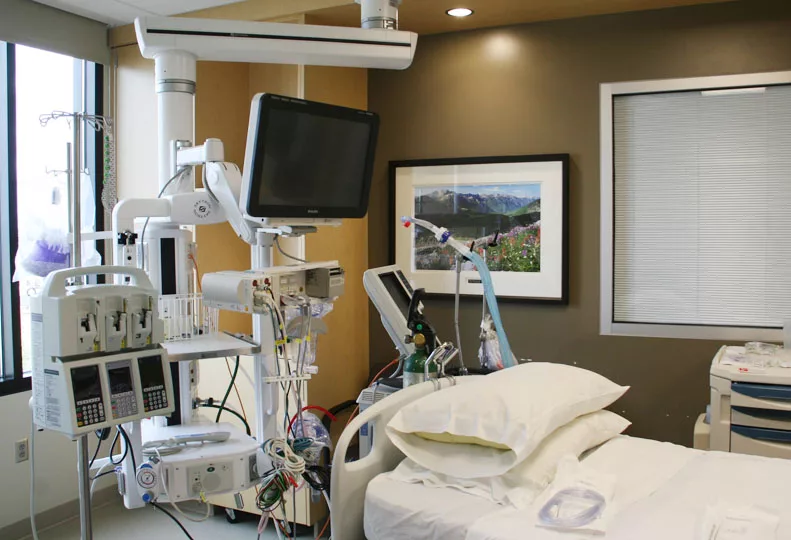Cardiac care expansion at Sacred Heart
$19.2 million project set to wrap up next February

Providence Sacred Heart Medical Center is underway on the second phase of a $19.2 million redesign and expansion of its cardiac intensive care unit.
The expansion is part of Sacred Heart’s goal of increasing its capacity to care for the most vulnerable patients with critical cardiac care needs.
Joyce Cameron, chief development officer for the Providence Health Care Foundation, says the first phase of the project, which included construction of a 12,400-square-foot expansion and a 2,000-square-foot courtyard, began in July 2014 and was completed early last May.
The second phase, which includes remodeling about 15,300 square feet of space, is expected to wrap up by next February. Once the improvements are completed, the facility will expand from 22 patient beds to a 34-bed intensive care unit.
Bouten Construction Co., of Spokane, is the contractor for the project, which was designed by Mahlum Architects Inc., of Seattle.
Cameron says Providence Health & Services, the Renton, Wash.-based parent of Spokane-based Providence Health Care, is putting $15.2 million toward the project from its capital budget. An additional $4 million is coming from donated donations, $2 million of which is still being raised by the foundation with the other $2 million being a matching gift from the foundation’s funds.
“Since kicking off the capital campaign in October of 2014, we have now raised just over $1.76 million from individuals, business, corporations, foundations, and special events,” she says. Donors will be honored on a special wall within the unit, and donors can also choose to purchase the naming of various areas within the unit with a large-enough donation.
According to its website, Sacred Heart performs more cardiovascular procedures than any facility in Washington state, handling about 15 percent of all adult cardiac surgeries performed in the state. In 2014, the center performed 1,017 open-heart procedures, or about 19 a week. Cameron says that once the CICU project is completed, the goal is to have enough surgeons, clinical staff, and space to perform 25 open-heart procedures each week routinely.
Kim Grippi, nurse manager for the CICU, says the unit currently has a staff of 120 people, a number she says is expected to increase by a third by the time the second phase is completed. She estimates the unit sees roughly 200 patients per month.
“The CICU offers heart and vascular recovery for an acute MI (myocardial infarction, or heart attack); full arrests; a VAD (ventricular assist device) bleed or symptoms requiring hospitalization; and of course transplant recovery,” says Grippi.
Some rooms are specifically designed to meet the needs of transplant patients and those with compromised immune systems who must recover or prepare for surgery in isolated, sterile environments.
Anne McKeon, Providence Health Care’s manager of marketing and communications, says some patients might need only minimally invasive surgeries, while others may need more complex treatment.
“The expansion will mean patients who need specialized heart or transplant care won’t have to travel far. It will allow us to see more patients, and therefore save more lives,” says McKeon.
As part of the redesign, the CICU’s new patient rooms will be 30 percent larger, with monitoring equipment located on a mounted boom to allow for caregivers to position equipment for more efficient patient care. Nurses’ charting stations are positioned between every two rooms, enabling nurses to view patients through windows as they’re working.
An open-air courtyard has also been added to the unit with the intention of giving patients, as well as their friends and family members, a reprieve away from the main hospital area.
“So far families and staff really appreciate the additional space both in patient rooms and the added courtyard,” says Grippi.
Other elements of the redesign include easy-to-follow, way-finding colored room numbers, and “physician business centers” or “team stations.” These stations are a separate space with computers for physicians to have privacy while updating medical records, and also serve as meeting areas for different staff teams to work together.
“Those spaces see a lot of use,” says Grippi. “Sometimes, we may have transplant teams who meet in there; other times, a doctor may hold a care conference with a patient’s family. It’s a nice space to be able to step away and focus, but still be near to the patients.”
Cameron says many of the new design features are the result of staff input and combining some of the best practices at leading cardiac care facilities across the country.
“These stations are a completely new system,” she says. “Right now, this is the only place in the hospital that is set up this way, but we will probably be looking at incorporating it into new expansions.”
McKeon says, “We’re always looking forward. It’s our goal to find out what’s needed through consulting with group leaders, to keep researching the newest technology and treatment methods so we can best meet the needs of the larger community.”
Providence Health & Services includes 34 hospitals, 475 physician clinics, senior services, supportive housing, and many other health and education services.
Together with its affiliates, it employs more than 76,000 people across the five states it serves.
Established in January 2006, Providence Health & Services formed when Spokane-based Providence Services, the parent company of Providence Health Care, merged with Seattle-based affiliate Providence Health System.
According to its website, Providence Health Services, along with its affiliates, had a total net income last year of $771 million on total net operating revenue of $12 billion, and it listed its total net assets at $7.9 billion.
It says it recorded community benefit and charity care costs of $848 million.
Related Articles
Related Products

_c.webp?t=1763626051)

_web.webp?t=1764835652)
